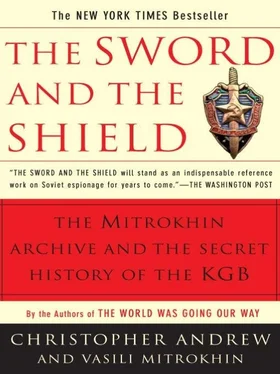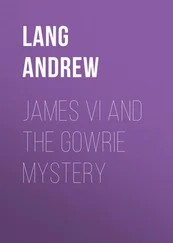Among the intelligence which most impressed the Centre was secret data on the vetting of ninety candidates for posts in the first Nixon administration. In 1969-70 twenty-three POCHIN intercepts were considered sufficiently important to be shown to leading members of the Politburo.
During the same period PROBA-1 (in the Soviet mission to the UN) and PROBA-2 (in the large embassy “dacha” at Glen Cove on Long Island) intercepted diplomatic traffic sent and received by the UN missions of Argentina, Brazil, Canada, France, Portugal, Spain and Venezuela, as well as some US military cables and the communications of Radio Liberty and Radio Free Europe. According to the PROBA files, the intelligence from these intercepts was given “a high evaluation” by both Foreign Minister Gromyko and the Soviet UN representative, Yakov Malik. 36
THE KGB’S SIGINT operations against the Main Adversary were greatly assisted by a series of agents and defectors—all of them walk-ins—with access to highly classified intelligence on American cryptanalysis and/or cipher systems. In 1960 two NSA employees, Bernon F. Mitchell and William H. Martin, who had made contact with the KGB a year earlier in Mexico City, were exfiltrated by the FCD to Moscow, where they continued being debriefed for several years. 37In 1963 Staff Sergeant Jack E. Dunlap committed suicide after several years spent smuggling top secret documents out of NSA headquarters at Fort Meade for the GRU. Shortly before Dunlap’s suicide, another NSA defector, Victor Norris Hamilton, arrived in Moscow. In 1965 Robert Lipka, a young army clerk at NSA responsible for the shredding of highly classified documents, began handing many of them over to the KGB. Lipka is the last KGB agent inside the NSA identified in the files seen by Mitrokhin. (A retired NSA employee, Ronald Pelton, was, however, to provide valuable intelligence to the Washington residency in the early 1980s.) Shortly after Lipka left NSA in 1967, Chief Warrant Officer John Walker, a communications watch officer on the staff of the commander of submarine forces in the Atlantic (COMSUBLANT), began an eighteen-year career as a KGB agent, supplying detailed information on US naval ciphers. 38
During the late 1960s both the New York and Washington residencies had a series of other striking SIGINT successes. Late in 1969 operation PRESSING, run by the New York residency, succeeded in concealing remote-controlled radio transmitters in UN offices used by the chairman of the Security Council. The devices, hidden in wooden boards, were fixed beneath bookcases and constructed from Western materials to conceal their Soviet origin. Simultaneously, operation KRAB, which almost certainly had to be approved by the Politburo, succeeded in bugging the secretariat of the UN secretary-general, U Thant (codenamed BROD). A radio-controlled eavesdropping device was also concealed in the offices of the Ghanaian mission to the UN. 39
In 1969 the Washington residency succeeded in concealing a remote-control radio-operated bugging device in the meeting room of the Senate Foreign Relations Committee. The device, once again constructed from Western materials, continued to function for at least four years. In February 1973 information (which may have been inaccurate) reached the residency from press sources that a bug had been found attached to the underside of the press table in the Foreign Relations Committee room. The KGB was puzzled by the report since its own listening device was fixed beneath the seat of a chair rather than under the table and still appeared to be functioning normally. Expecting its bug to be discovered, Service A prepared a story claiming that it had been placed by the DGSE, the French foreign intelligence service. To the KGB’s surprise, however, the media lost interest in the episode and no report of the bug beneath the chair appeared in the press. 40
EARLY IN 1968 the KGB achieved its most important penetration of British SIGINT operations since John Cairncross had entered Bletchley Park in 1942. Corporal Geoffrey Arthur Prime, then working in the RAF SIGINT station at Gatow in West Berlin, handed a message to a Russian officer at a Soviet checkpoint asking Soviet intelligence to make contact with him. Prime’s note was passed not to the FCD but to the comparatively lowly KGB Third Directorate, whose main responsibility was the surveillance and security of Soviet armed forces but which sometimes succeeded in making (usually low-level) recruits among Western troops stationed in Germany. Anxious to steal a march over the more prestigious FCD by gaining the credit for Prime’s recruitment, a Third Directorate officer left him a message, inviting him to a rendezvous in East Berlin, in a small magnetic cylinder attached to his car door. At the meeting which followed and at subsequent rendezvous, Prime agreed to work as a KGB agent but explained that his service with the RAF was due to end in August 1968. In agreement with his Third Department case officers he applied, successfully, for a job processing Russian intercepts at GCHQ, the British SIGINT agency.
Prime was a sexual and social misfit who blamed many of his problems on the capitalist system and, as he later acknowledged, developed “a misplaced idealistic view of Russian Communism.” He was, however, skillfully handled by his controllers. In September 1968, before taking up his job in GCHQ, Prime spent a week in the KGB compound at Karlshorst in the East Berlin suburbs being trained in radio transmission, cipher communications, microdots, photography of documents with a Minox camera and the use of dead letter-boxes. Before flying to Britain, he was given a briefcase containing a set of one-time cipher pads, secret writing materials and 400 pounds in banknotes. He continued working as a Soviet agent in GCHQ for almost nine years, spending most of his time transcribing and translating intercepts. Among the intelligence supplied by Prime during his final year working for GCHQ in 1976-7 were details of British successes and failures in decrypting Soviet traffic. Though his GCHQ colleagues were struck by his morose appearance, they put it down to his unhappy marriage and failure to be promoted. 41
The expansion of KGB SIGINT operations during the late 1960s led to a reorganization at the Centre. Hitherto the KGB Eighth Directorate had handled SIGINT as well as ciphers and communications. Probably in 1968 Andropov established a new Sixteenth Directorate, 42headed by Nikolai Nikolayevich Andreev, to specialize exclusively in SIGINT. Its operations were among the most highly classified in the whole of the KGB. The Sixteenth Directorate worked closely with the Sixteenth Department of the FCD, founded at about the same time, which was given responsibility for residency intercept posts, operations to acquire foreign codes and ciphers and attempts to penetrate other SIGINT agencies. 43On May 15, 1970 Andropov approved a plan for radio-intercept posts (some were already functioning) in fifteen residencies: Washington, New York, Montreal, Mexico, Tokyo, Peking, Teheran, Athens, Rome, Paris, Bonn, Salzburg, London, Reykjavik and Belgrade. During 1971 these fifteen posts intercepted a total of 62,000 diplomatic and military enciphered cables from 60 countries, as well as more than 25,000 plain text messages. 44
The most important intercept posts, operated by the Sixteenth Department with the assistance of OT personnel, remained the Washington area POCHIN and New York PROBA stations. The most striking achievement of the POCHIN stations during the 1970s was the interception of many of the messages exchanged between Washington, via Andrews Air Force Base, and the aircraft taking the President, Secretary of State and other senior members of the administration on overseas trips. ANTON, one of the POCHIN operational officers, was awarded the Order of the Red Star for his success in intercepting US communications during Kissinger’s visit to London in July 1974 for talks with the British Foreign Secretary (and future prime minister), James Callaghan. 45The Centre’s particular interest in these intercepts doubtless derived from the fact that the main purpose of Kissinger’s visit was to brief Callaghan on Nixon’s recent visit to Moscow—his last foreign trip before his resignation at the height of the Watergate scandal. 46Soon afterwards the PROBA stations succeeded in intercepting Kissinger’s telephone conversations with Callaghan and the Turkish foreign minister, Professor Turan Gånes, during the crisis caused by the Turkish invasion of northern Cyprus on July 21. 47The KGB was thus able to monitor the dramatic way in which, as Kissinger later recalled:
Читать дальше











